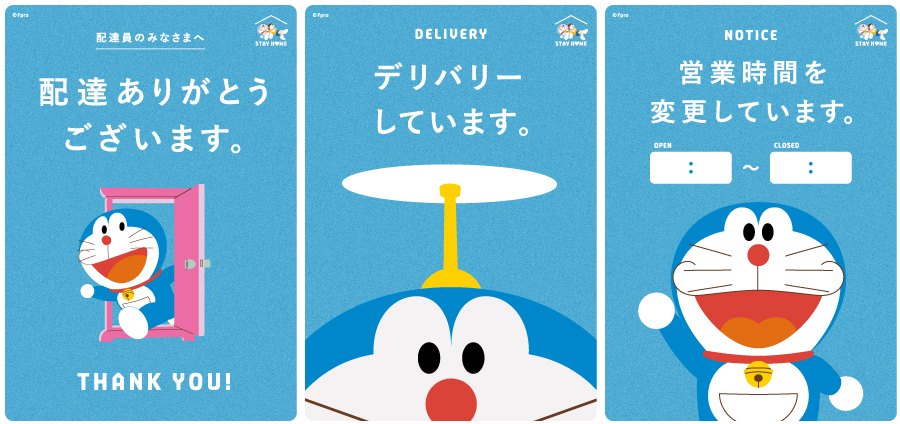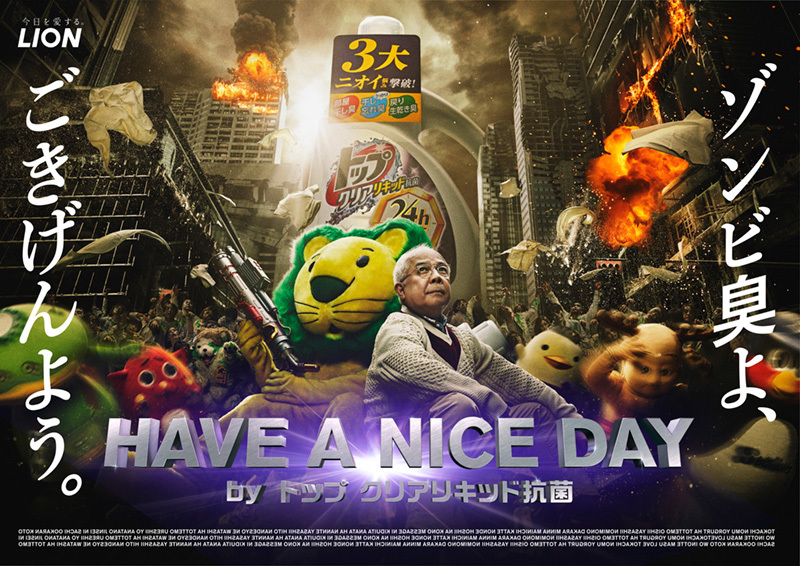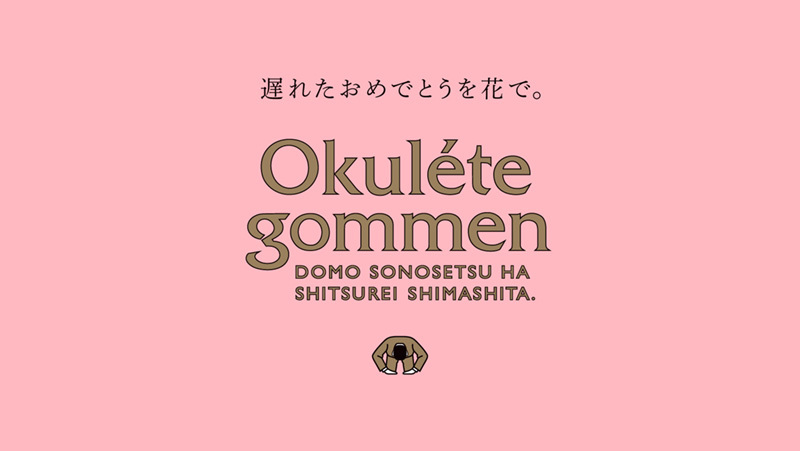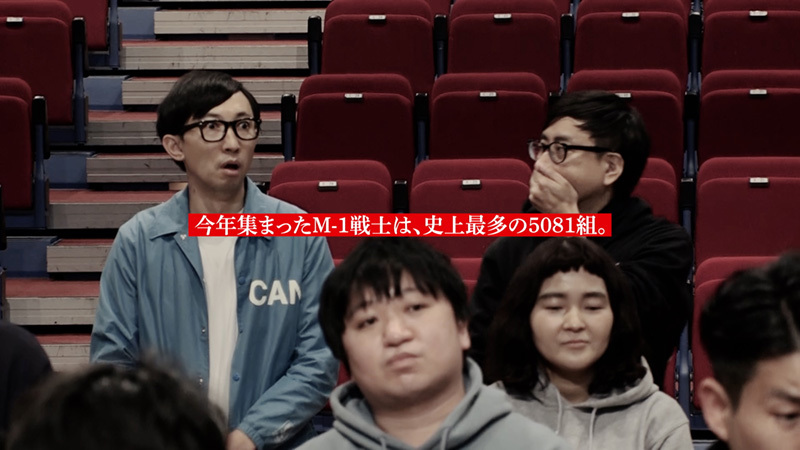Dentsu Inc.'s cross-functional creative organization, the "Future Creative Center" (FCC), is a group of over 70 individuals supporting future-building initiatives with creativity beyond the confines of advertising. In this series, centered on the theme "Future × Creativity," center members discuss their upcoming endeavors.
Last year's Golden Week saw significant "fatigue from self-restraint" due to the state of emergency declaration. During this time, a message delivered by Doraemon across Japan became a hot topic. It was the "Doraemon STAY HOME PROJECT," launched through newspaper ads and other channels. The newspaper ads were translated into eight languages and shared globally.

Newspaper ad translated into 8 languages
The individuals behind this initiative were Sayaka Arimoto (Copywriter/Planner, Dentsu zero) and Yohei Nemoto (PR Producer, Dentsu Public Relations), both members of Dentsu FCC. Amidst days filled with uncertainty for everyone, how did the message from Doraemon, a beloved national character, come to be? We spoke with them about the background of this project and their approach to advertising communication.

※This interview was conducted online.
A Message Only Doraemon Could Deliver Amid Widespread Anxiety
Arimoto: The impetus for the "Doraemon STAY HOME PROJECT" came from Yohei's actions right at the start of the lockdown period. As the world was changing dramatically, he was consulting with various staff members about what we could do to utilize our creativity and ideas. Among them, someone I had worked with previously was at Fujiko F. Fujio Productions (Fujiko Pro), and that connection led to this project.
Nemoto: Spring 2020 was a time when I felt the helplessness of someone like me, whose livelihood depends on communication. Still, since that's all I could do, I felt compelled to explore how communication might offer some form of support.
Arimoto: 2020 also marked Doraemon's 50th anniversary. But with the movie release postponed and the spring situation, it felt far from a celebratory mood. Yet, precisely because Doraemon is beloved throughout Japan, I thought there must be something we could do in this situation. I proposed it to Fujiko Pro, and the project started.
For this project, we ran a newspaper ad on April 29th, the first day of Golden Week. Then, on Children's Day, May 5th, we published a message for children: "Let's be Nobita."

May 5th Newspaper Ad: "Let's Be Nobita."
We also created posters to support restaurants and delivery workers. Designed for free download, they were used by restaurants starting takeout or delivery services and displayed as messages of gratitude to delivery workers.

Support Posters for Restaurants and Delivery Workers
When crafting the copy, I was particular about ensuring that, coming from a national icon like Doraemon, the message wouldn't hurt anyone. At the time, the virus was even more unknown than it is now, and everyone was deeply anxious. With the whole world being so sensitive, I wanted to avoid Doraemon supporting only specific people or indirectly causing anyone distress. To refine the copy, I turned to social hunting.
The deep-seated "insights" within people surface on SNS (= the outside world)
Fundamental:Social hunting is a method of analyzing the words overflowing on social media to uncover what triggers people's anger, sadness, or joy today. Traditionally, genuine human feelings and deep emotions—these "insights"—remained hidden and were investigated through various methods. However, with the widespread adoption of SNS, these insights now surface online. This phenomenon is often described as the "Outside Insight" concept. Drawing on such approaches, we imagined the reactions people might have upon receiving Doraemon's message.
Moreover, I believe the term "target audience" is becoming obsolete in today's media landscape. Whether it's newspaper ads, outdoor billboards, or TV commercials, the power of social media (for better or worse) means messages often spread beyond the intended audience. It's extremely difficult to limit who receives your message. Furthermore, values are diversifying. When communicating something, it's crucial to imagine "someone not physically present" as deeply as possible. Striking a chord with the intended audience while avoiding discomfort among others outside that circle is far from simple, but I feel it's one of the most essential skills needed in this era.
Arimoto: For example, the slogan "Let's be Nobita!" could feel counterproductive to those who couldn't take time off work during that situation. So we discussed it and decided to deliver this message specifically to children on Children's Day. We encouraged them: "Even though you can't go out to play yet, let's try to relax as hard as Nobita does. That's how we'll save the world." We added furigana to the kanji, creating copy that children staying home could read together with their families. We believed clearly establishing this stance throughout the copy was crucial to prevent misunderstandings if people outside the target audience encountered it.
Nemoto: Social hunting has been used in various marketing efforts in recent years. One example is Lion's initiative. Analyzing laundry-related concerns through social hunting revealed frequent dissatisfaction with the three major odor problems: room-drying smell, forgotten-to-dry smell, and lingering dampness smell. The common thread was that clothes smelled despite being properly washed. Even after thorough washing, family members would say, "This smells bad—did you even wash it?" Consequently, multiple people expressed frustration specifically about that phrase.

Lion "Top Clear Liquid Antibacterial" Promotion
Discovering these genuine feelings surfacing on social media, Lion realized it wasn't the person's fault. By focusing on the odor itself, they wondered if they could charmingly bridge that family divide. Thus, Lion decided to affectionately nickname this odor " zombie smell." Even with a theme not yet widely discussed, raising the issue makes many people think, "Oh, that's me!" and want to engage. Social hunting is also useful for finding such issues.
The depth of communication comes from "reflection"
Arimoto: The " Okurete Gommen " project we're doing with Nemoto-kun for the Japan Flower Promotion Council is another example. During the pandemic, I saw many people on social media who couldn't meet others or celebrate anniversaries and milestones. We thought, "Why not encourage them to celebrate with flowers? Even if it's late, they'll surely be happy."


Japan Flower Promotion Council's "Okurete Gommen" Project
Nemoto: Even before COVID, I'd sometimes forget to send birthday wishes to friends via LINE, so missed celebrations weren't entirely new. But after the pandemic hit, mentions of these missed celebrations on social media skyrocketed. That's a clear sign of a trend.
This kind of analysis becomes increasingly important as values diversify. However, for communicators like Mr. Arimoto, this diversification of values also creates challenges, doesn't it? Words that make someone happy can potentially hurt someone else. Within that context, deepening the level of communication itself presents difficulties. If you aim for depth, you inevitably need to limit the audience for your message.
Arimoto: That's a difficult part, but I believe sincerity is crucial. How genuinely are you delivering the message to your target audience? If there's no deception there, even those outside the target group will understand. And what I felt might hint at deepening the connection with the target audience is the "space around information" and "excessive information." They're opposite phenomena, but leaning heavily into either one sparks "reflection."
I felt this during the production of the M-1 Grand Prix promotional video. We wanted to convey the intensity, so we leaned heavily into increasing the information volume. For the 2019 version, we included an overwhelming amount of copy that couldn't be fully captured in the video itself. For the 2020 version, we increased the information density within the video footage. This led to fascinating phenomena: people transcribing the copy into the YouTube comments, discussions about the editing choices, and the comment section itself functioning as a separate medium.

M-1 Grand Prix 2019 "The Night Before the Night Before the Night Before" × "The Life Before the Life Before the Life Before" Promotion

From the M-1 Grand Prix 2020 × Creepy Nuts "Monster on the Board" Special Movie
Nemoto: So based on the massive amount of information packed into the commercial, fans started discussing it spontaneously, right?
Arimoto: Yes. Some people watched the video multiple times for those discussions, and I felt that led to depth. The same applies to leaving room for interpretation. When you create space within a production, each person imagines, "Maybe it means this," and starts talking about it. Advertising isn't a one-way street where you just say what you want and it ends there. It can also become a question that allows viewers to discuss the same theme. Rather than being self-contained, if advertising can be seen as an item that deepens the connection with the sender through the viewer's imagination, I believe it can become an important tool for strengthening bonds.
Toward a Team Standardly Equipped with CR×PR, Creative Expression and Information Creation
Arimoto: We've jumped around a bit, but I hoped today would show how combining these two perspectives expands advertising's potential... I wonder if it came across...? While creating ads without a PR viewpoint is impossible these days, working closely with a PR pro like Nemoto-kun is relatively new for me, and it's brought many discoveries.
Nemoto: It's like a personal team and a public team, right? My team discovers public insights, and Arimoto-san's team translates them into ideas that resonate more personally. Finally, we double-check for risks from a public perspective. You could call it expressive creativity and informational creativity.
Arimoto: The scope of what two people can imagine together is broader than what one person can imagine alone. That synergy between PR and creative feels really powerful.
Nemoto: Especially when creating mass advertising, it's crucial how well you can imagine people not right in front of you. How well you can anticipate the environments and problems faced by many people to refine your plans. In this era of diversifying values, I feel more and more every day that this isn't just nice to have—it's becoming an essential skill. For me personally, to consciously correct my own unconsciously fixed values, there's really nothing but daily study...
Expanding and deepening that scope and depth of imagination by collaborating across different fields. To ensure advertising continues to genuinely move people's hearts, I want to keep pursuing this without giving up.


















